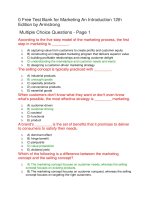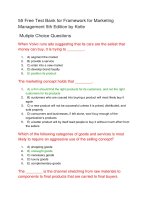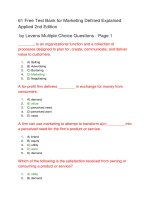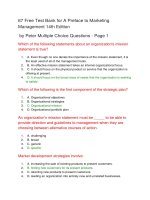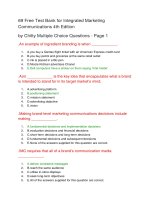Free test bank for marketing research 2nd asia
Bạn đang xem bản rút gọn của tài liệu. Xem và tải ngay bản đầy đủ của tài liệu tại đây (149.29 KB, 32 trang )
Free Test Bank for Marketing Research 2nd Asia
Pacific Edition by Zikmund Mutiple Choice Questions
The systematic and objective process of generating information to
improve marketing decisions is the essence of:
1.
A.marketing research
2.
B.applied research
3.
C.basic research
4.
D.subjective research
When Harley-Davidson determines that their typical motorcycle
owner has a household income over $50 000, is male, and is about
38 years old, what type of study is this?
1.
A.market segmentation study
2.
B.product research study
3.
C.performance-monitoring study
4.
D.distribution research study
A company manager is facing declining sales but doesn’t know
why. Which type of research design would you recommend to
address this problem?
1.
A.exploratory research
2.
B.descriptive research
3.
C.causal research
4.
D.secondary research
Asking consumers what they think about a possible brand name for
a new product is an example of which type of research?
1.
A.pricing research
2.
B.promotion research
3.
C.product research
4.
D.distribution research
When Coles supermarket is attempting to decide where to locate its
regional warehouses in order to minimise travel time to its stores,
which type of research is this an example of?
1.
A.distribution research
2.
B.pricing research
3.
C.promotion research
4.
D.product research
When McDonald's studies traffic patterns and population density
patterns in order to select sites for future restaurants, this is an
example of which type of research?
1.
A.pricing research
2.
B.distribution research
3.
C.promotion research
4.
D.product research
When an organisation is attempting to decide whether to add home
delivery to its customer service options, this is an example of which
type of research?
1.
A.distribution research
2.
B.pricing research
3.
C.promotion research
4.
D.product research
Research that tries to verify a theory or to learn more about a
certain concept is the essence of:
1.
A.performance-monitoring research
2.
B.pure research
3.
C.applied research
4.
D.forecasting research
Determining the need for marketing research centres on all the
following except:
1.
A.the nature of the decision
2.
B.researcher competency
3.
C.the availability of the data
4.
D.time constraints
A librarian assesses the amount of wear to book bindings to
determine which books are most borrowed. This is an example of:
1.
A.product research
2.
B.survey research
3.
C.observational research
4.
D.experimental research
A local book publisher would like to investigate possible options to
improve the accessibility of their titles to customers. This would
involve:
1.
A.product research
2.
B.pricing research
3.
C.distribution research
4.
D.promotional research
Which of the following type of research is conducted to investigate
the effectiveness of discounts or coupons?
1.
A.promotion research
2.
B.pricing research
3.
C.distribution research
4.
D.product research
The research question ‘Which of the two advertising campaigns is
more effective?’ is best addressed by conducting:
1.
A.secondary research
2.
B.causal research
3.
C.exploratory research
4.
D.descriptive research
Observation technique is most useful when studying:
1.
A.attitudes
2.
B.opinions
3.
C.motivations
4.
D.behaviours
ANZ bank monitors its online customer service activities regularly to
ensure that its Internet banking caters to its customers’ needs.
Which type of research is this an example of?
1.
A.relationship marketing research
2.
B.total quality management research
3.
C.opportunity assessment research
4.
D.performance-monitoring research
When Chee-tos snack food conducted research in China to
determine which flavours consumers would find appealing, this was
an example of which type of research?
1.
A.pricing research
2.
B.promotion research
3.
C.product research
4.
D.distribution research
The research question ‘What features do buyers prefer in our
product?’ is best addressed by conducting:
1.
A.descriptive research
2.
B.exploratory research
3.
C.causal research
4.
D.secondary research
Research that attempts to determine which critical attributes of a
product consumers use to perceive its value is an example of which
type of research?
1.
A.product research
2.
B.distribution research
3.
C.promotion research
4.
D.pricing research
Research conducted to address questions about a specific real-life
problem is the essence of:
1.
A.basic research
2.
B.pure research
3.
C.applied research
4.
D.intuitive research
Which type of product research is conducted to determine whether
a finished product out-performs its competitors or meets
expectations?
1.
A.concept testing
2.
B.package testing
3.
C.brand-name evaluation
4.
D.product testing
Nokia would like to determine which features are most popular with
consumers when buying mobile phones. Which type of research
design would you recommend to address this problem?
1.
A.causal research
2.
B.descriptive research
3.
C.exploratory research
4.
D.secondary research
The first stage of developing and implementing a marketing strategy
involves:
1.
A.analysing market segments and selecting target markets
2.
B.identifying and evaluating opportunities
3.
C.analysing marketing performance
4.
D.planning and implementing a marketing mix strategy
When a toy company shows different versions of a proposed TV
commercial to groups of children and observes which one grabs
their attention most, what is this an example of?
1.
A.secondary data study
2.
B.survey research study
3.
C.experimental study
4.
D.performance-monitoring research
Information obtained from marketing research can be used for all
the following except:
1.
A.evaluate marketing activities
2.
B.monitor marketing performance
3.
C.identify marketing opportunities
4.
D.ensure correct marketing execution
The initial stage of the research process involves:
1.
A.planning the research design
2.
B.defining the problem
3.
C.defining the sample size
4.
D.planning the data analysis procedure
25 Free Test Bank for Marketing Essentials 2nd Edition
by Dibb Mutiple Choice Questions
_____ of marketing plans hinges on coordination of marketing
activities, motivation of marketing personnel, and effective
communication within the marketing unit.
1.
a. Implementation
2.
b. Planning
3.
c. Organizing
4.
d. Marketing control
5.
e. Strategic planning
Which of the following scenarios involves the distribution element of
the marketing mix?
1.
2.
3.
a. Deciding whether or not a certain product should continue to be sold
b. Determining whether an advertising message would be more effective on
television or in magazines
c. Choosing between a company jet or the airlines for executive travel
4.
d. Deciding whether or not to have retail outlets in addition to a website
5.
e. Developing a new warranty policy for an existing product
The marketing mix is built around _____
1.
a. the product, brand or position
2.
b. company technology
3.
c. buyer or consumer satisfaction.
4.
d. employee satisfaction
5.
e. the retail outlet.
A target market:
1.
2.
a. involves a large number of customers.
b. is a specific group of customers on whom a company focuses its marketing
efforts.
3.
c. already has several competitors vying for customers' business.
4.
d. is the same as a salesperson's prospective client list.
5.
e. is a customer group classified as people with similar demographic
characteristics.
The definition of marketing implies that ____ should receive
benefits from exchange relationships.
1.
a. only customers
2.
b. only businesses
3.
c. company management
4.
d. both customers and businesses
5.
e. only the most important customers
Which of the following statements about marketing environment
forces is correct?
1.
a. They influence customers by affecting their lifestyles, standards of living,
and preferences and needs for products.
2.
b. They do not influence customers' reactions to a firm's marketing mix.
3.
c. They fluctuate slowly and thereby create threats to a firm's marketing mix.
4.
d. They never fluctuate quickly.
5.
e. They do not influence the way a marketing manager performs certain
marketing activities.
A market orientation is an organization-wide effort that includes all
of the following activities except:
1.
a. researching customers' needs.
2.
b. focusing on the marketing department only.
3.
c. generating marketing intelligence for use in the organization.
4.
d. being responsive to customers' ever-changing wants and needs.
5.
e. disseminating marketing intelligence across departments within the
organization.
The forces of the marketing environment primarily affect marketers
in three ways: They influence customers by affecting their lifestyles
and preferences for products; they determine whether or how a
marketing manager can perform certain marketing activities; and
they
1.
a. affect a marketing manager's decisions and actions by influencing buyers'
reactions to: the firm's marketing mix.
2.
b. dictate that changes be made to the existing marketing mix despite any
negative reactions from customers.
3.
c. make most new products obsolete very quickly so that research and
development must continually develop new products.
4.
d. cause most advertising to be ineffective at communicating product benefits
due to rapidly changing environmental forces.
5.
e. change a customer's decisions about the appropriate marketing mix for the
company and its various products.
The marketing concept is:
1.
a. a management philosophy.
2.
b. synonymous with exchange.
3.
c. a component of the marketing mix.
4.
d. a function of the marketing environment.
5.
e. focused solely on satisfying customer objectives.
Marketing management is defined as a process of:
1.
a. maintaining an appropriate and efficient marketing mix for a target market.
2.
b. establishing performance standards and evaluating actual performances
against these standards.
3.
c. providing products that satisfy customers' needs through a coordinated set
of activities.
4.
d. facilitating satisfying exchanges between an organization and its
customers.
5.
e. planning, organizing, implementing, and controlling marketing activities.
The three basic forms that a product can take are _____
1.
a. markets, products, and images.
2.
b. goods, ideas, and intangibles.
3.
c. brands, services, and tangibles.
4.
d. services, ideas, and goods.
5.
e. ideas, services, and things.
Marketing activities:
1.
a. are aimed at persuading customers through advertising.
2.
b. involve mainly distribution and promotion decisions.
3.
c. and selling activities are basically the same.
4.
d. are important only when a firm is developing new products or entering new
markets.
5.
e. help sell an organization's products and generate financial resources for the
firm.
The marketing concept is best defined as:
1.
a. a second definition of marketing.
2.
b. a philosophy stating that an organization should try to satisfy customers'
needs through a coordinated set of activities that allows the organization to
achieve its goals.
3.
c. the performance of business activities that direct the flow of goods and
services from producer to customer or user.
4.
d. a philosophy stating that an organization should attempt to accomplish its
goals with no regard for the needs of customers.
5.
e. the inclusion of marketing activities in the activities of an organization.
Today, establishing long-term, mutually beneficial arrangements in
which both the buyer and seller focus on value enhancement
through the creation of more satisfying exchanges is known
as_______
1.
a. marketing synthesis.
2.
b. relationship marketing.
3.
c. a marketing orientation.
4.
d. the marketing concept.
5.
e. strategic marketing.
Distribution, price, promotion, and product are all elements of_____
1.
a. marketing strategy.
2.
b. the marketing mix.
3.
c. a target market.
4.
d. a consumer good.
5.
e. a business strategy.
The marketing concept is a management philosophy that affects:
1.
a. only marketing activities.
2.
b. all efforts of the organization.
3.
c. mainly the efforts of sales personnel.
4.
d. mainly customer relations.
5.
e. only business organizations.
The focal point of all marketing activities is ______
1.
a. products.
2.
b. the marketing mix.
3.
c. profits.
4.
d. sales.
5.
e. customers.
Managing customer relationships requires identifying patterns of
____ and then using that information to focus on the most
promising and profitable customers.
1.
a. demographics
2.
b. buying behaviour
3.
c. retailer information
4.
d. personality differences
5.
e. stock market cycles
Marketing is the management process:
1.
a. of promoting products through personal selling and advertising to develop
and maintain favorable relationships with customers and stakeholders.
2.
3.
4.
5.
b. responsible for identifying, anticipating and satisfying customer
requirements profitably.
c. for delivering a standard of living to a society.
d. of creating, distributing, promoting, and pricing goods, services, and ideas
to facilitate the achievement of the firm's objectives.
e. focusing on customers' needs.
____ is provision or transfer of goods, services and ideas.
1.
a. Marketing orientation
2.
b. Monetary price
3.
c. Product assessment
4.
d. Price assessment
5.
e. Value
_____ is the degree to which an exchange helps achieve an
organization's objectives.
1.
a. Controlling
2.
b. Effectiveness
3.
c. Success rate
4.
d. Efficiency
5.
e. Objectivity
The forces of the marketing environment include:
1.
a. political, legal and regulatory, sociocultural, technological, economic, and
competitive.
2.
b. sociocultural, legal, regulatory, economic, and competitive.
3.
c. legal, regulatory, political, and sociocultural.
4.
d. competitive and noncompetitive forces that affect most lifestyles.
5.
e. fairly static components.
_____ refers to minimizing the resources an organization must
spend to achieve a specific level of desired exchanges.
1.
a. Effectiveness
2.
b. Productivity
3.
c. Efficiency
4.
d. Objectivity
5.
e. Cost cutting
Which of the following is most likely to be an idea marketer?
1.
a. Car salesperson
2.
b. Airline pilot
3.
c. Lawyer
4.
d. Marriage counselor
5.
e. Orthodontist
Marketers often speak of the "controllable" variables in the practice
of marketing. Which of the following is not considered one of the
controlled variables?
1.
a. Product
2.
b. Price
3.
c. Distribution
4.
d. Competition
5.
e. Promotion
25 Free Test Bank for Marketing Essentials 2nd Edition
by Dibb True - False Questions
To implement the marketing concept, an organization must first
establish an information system to discover customers' real needs
and then use the information to create products to satisfy those
needs.
1.
True
2.
False
The Marketing era was the period in which product and aggressive
selling were no longer seen to suffice if customers either did not
desire a product or preferred a rival brand, and in which customer
needs were identified and satisfied
1.
True
2.
False
The marketing concept deals only with marketing activities.
1.
True
2.
False
During the market orientation, businesspeople realized that
products, which by this time could be made relatively efficiently,
would have to be promoted through much personal selling and
advertising.
1.
True
2.
False
Customers are the focal point of all marketing activities.
1.
True
2.
False
For an exchange situation to arise, only one condition must exist:
two or more individuals, groups, or organizations must each
possess something that they value and are willing to give up to
receive the "something of value" held by the other individual, group,
or organization.
1.
True
2.
False
Promotion can help sustain interest in established products that
have long been available.
1.
True
2.
False
Customer benefits include time and effort.
1.
True
2.
False
The actual physical production of goods is a marketing activity.
1.
True
2.
False
A target market is always defined by demographics.
1.
True
2.
False
The marketing environment is a set of static, unchanging
surroundings.
1.
True
2.
False
The outcomes of a marketer's decisions and actions may be
affected by the variables in the marketing environment.
1.
True
2.
False
In marketing management, planning is a systematic process of
assessing opportunities and resources, determining marketing
objectives, and developing a marketing strategy and plans for
implementation and control.
1.
True
2.
False
Marketing efforts do not involve the design and development of
products.
1.
True
2.
False
Profit, even at the expense of customers' satisfaction, is the major
thrust of the marketing concept.
1.
True
2.
False
In general, when marketers focus on customers chosen for their
lifetime value, they earn lower profits in future periods than when
they focus on customers selected for other reasons.
1.
True
2.
False
Customers are interested in a product's price because they are
concerned about the value obtained in an exchange.
1.
True
2.
False
Changes in the marketing environment always hurt marketing
efforts.
1.
True
2.
False
The market concept developed out of a sequence of three eras: the
production orientation, the marketing orientation, and the industrial
orientation.
1.
True
2.
False
Marketing management is the process of planning, organizing,
implementing, and controlling marketing activities to facilitate and
expedite exchanges effectively and efficiently.
1.
True
2.
False
The process people use to determine the value of a product is not
highly scientific.
1.
True
2.
False
Services are provided by applying human and mechanical efforts to
people or objects.
1.
True
2.
False
The marketing concept stresses that a business organization can
best achieve its goal by providing customer satisfaction through
coordinated activities.
1.
True
2.
False
The marketing concept is a philanthropic philosophy aimed at
helping customers at the expense of the business organization.
1.
True
2.
False
At the most basic level, profits can be obtained through
relationships by acquiring new customers, enhancing the
profitability of existing customers, and extending the duration of
customer relationships.
1.
True
2.
False
44 Free Test Bank for MKTG2 2nd Asia Pacific Edition
by Lamb Mutiple Chocie Questions
When a company uses its resources to resolve questions like,
‘What can we do best?’, ‘What can our engineers design?’ and
‘What is easy to produce with our equipment?’, it is said to have a
_____ orientation.
1.
A sales
2.
B customer
3.
C marketing
4.
D production
5.
E value
When a company’s focus is on keeping existing customers and
suppliers, it is said to have a _____ orientation.
1.
A marketing
2.
B sales
3.
C customer
4.
D relationship
5.
E production
A business is concerned with many day-to-day activities. Some of
the most important are the planning and conception of the product
or service, its pricing policy and the distribution strategy. These
activities are all a part of:
1.
A engineering
2.
B marketing
3.
C accounting
4.
D production
5.
E human resources
An organisation with a(n) _____ believes that it exists not only to
satisfy customer wants and needs and to meet organisational
objectives, but also to preserve or enhance individuals’ and
society’s long-term best interests.
1.
A implementable strategy
2.
B marketing orientation
3.
C ethical business mission
4.
D societal orientation
The philosophy that assumes people are resistant to buying
products that are not absolutely necessary is called the _____
orientation.
1.
A marketing
2.
B sales
3.
C customer
4.
D production
5.
E discount
Fujifilm Computer Products has improved the efficiency and
productivity of its plant, which manufactures printing technology. For
the new financial year, the company projects a production increase
of 25 per cent and has instructed its sales force to aggressively
distribute and promote the product. The CEO is sure that the
market will absorb more product if the sales force is determined and
assertive. Fujifilm appears to have a _____ orientation.
1.
A marketing
2.
B production
3.
C sales
4.
D customer
5.
E marketplace
For an exchange to occur:
1.
A money is essential
2.
B organisational profit is required
3.
C third-party involvement is required
4.
D each party must have something that is of value to the other party
5.
E the buyer cannot reject the offer once the offer is accepted
_____ is an (are) effective tool(s) in generating relationships with
customers.
1.
A Sales personnel
2.
B The Internet
3.
C Coupons
4.
D Publicity
5.
E Product placements
Exchange can take place only if _____ is given or received.
1.
A money
2.
B something of value
3.
C cost of time
4.
D cost of travel
5.
E opportunity cost
Most of the successful companies are focused on packaging with
less toxic, more durable and reusable materials. This is an example
of a company using _____ orientation.
1.
A production
2.
B relationship marketing
3.
C profitability
4.
D sales
5.
E societal
A _____ orientation assumes that customers resist buying items
that are not essential and that people will buy more goods and
services if aggressive marketing techniques are used.
1.
A sales
2.
B production
3.
C marketing
4.
D customer
5.
E marketplace
At the core of every business are the activities that determine
survival, profits and growth. Marketing contributes to these activities
through five principal means. The first one is assessing the wants of
customers, and the other four include all of the following EXCEPT:
1.
A aggressive human resource practices
2.
B pricing policies
3.
C communication with customers
4.
D distribution strategies
When a customer’s expectations are exceeded, _____ occurs.
1.
A confirmation
2.
B satisfaction
3.
C value creation
4.
D achievement
5.
E need
Consumer complaints are an important aspect of business. A
company receiving customer complaints and focusing on a sales
orientation is likely to:
1.
A modify the sales presentation
2.
B change the product
3.
C analyse the target market and revise distribution
4.
D coordinate feedback into future product offerings
5.
E change the pricing structure
A firm that lacks an understanding of the needs and wants of the
marketplace is called:
1.
A market-oriented
2.
B sales-oriented
3.
C profit-oriented
4.
D customer relationship-oriented
5.
E promotional-oriented
In a situation where there is weak competition or when the demand
exceeds supply, a _____-oriented company can be very
successful.
1.
A marketing
2.
B societal
3.
C retailing
4.
D production
5.
E sales
Megan is a telephone order-taker for Myer Direct. A customer called
and asked if the blue in a tablecloth that she had purchased
matched the blue in a rug that was being offered in Myer Direct’s
newest catalogue. Megan got the potential customer’s phone
number, went out to the warehouse, located the items, determined
they did not match and called the potential customer to tell her that
information. Megan showed a _____ orientation.
1.
A societal
2.
B market
3.
C sales
4.
D relationship
5.
E production
An area which is relatively new in business study and likely to be
modified as academics and practitioners understand more about it
is called:
1.
A science
2.
B marketing
3.
C sports management
4.
D management
5.
E psychology
Which of the following is NOT an element of the marketing mix?
1.
A price
2.
B place
3.
C positioning
4.
D product
5.
E promotion
The Paul’s Milk company asks the consumer to return the top of the
plastic container to the shop so that it may help in generating
finances for local schools. The more milk-bottle tops, the larger the
donation to local educational institutions. Paul’s Milk is displaying:
1.
A sales-closing marketing
2.
B customer-need marketing
3.
C marketing contribution
4.
D marketing engineering
5.
E societal marketing
Danny Miller wants to sell his four-wheel-drive truck. A preliminary
investigation has shown that many people would be interested in
this type of truck. He has taken out an advertisement in his local
trade paper and provided customers with a toll-free number to make
an appointment to drive the truck. He has read in the auto trade
papers that similar trucks to the one that he owns are selling for
about $15 000. Before accepting this opportunity, what else should
Miller find out about?
1.
A production
2.
B customers
3.
C value
4.
D satisfaction
5.
E sales
Understanding your competitive arena and competitors’ strengths
and weakness is a critical component of _____ orientation.
1.
A marketing



